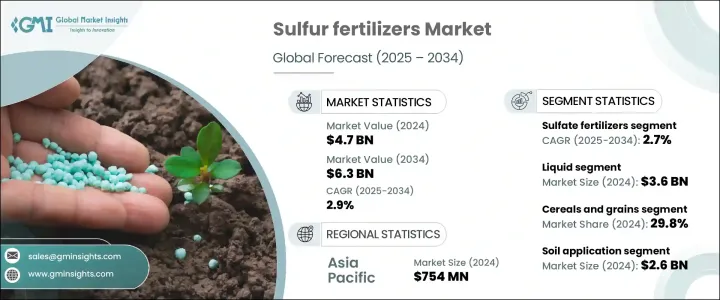
세계의 유황비료 시장은 2024년에 47억 달러로 평가되었으며, 주요 농업 지역 전체에서 작물 생산성 향상과 토양 건전성 개선에 대한 수요 증가에 힘입어 CAGR 2.9%를 나타내 2034년까지는 63억 달러에 이를 것으로 예측되고 있습니다.
세계의 식량 소비량이 계속되고 있는 가운데, 농가는 한정된 경작지로부터 최대한의 수량을 확보할 필요에 강요되고 있습니다. 2차 다량 영양소인 유황은 엽록소 형성, 효소 활성, 단백질 합성과 같은 식물의 대사 기능을 지원하는 데 중요한 역할을 합니다.

농업 부문, 특히 신흥 경제국에서는 첨단 작물 영양 전략의 통합으로 큰 변화가 일어나고 있습니다. 이에 대한 인식이 높아짐에 따라 이 시장은 영세농가와 대규모 상업경작자 모두에게 강한 지지를 받고 있습니다.
| 시장 범위 | |
|---|---|
| 시작 연도 | 2024년 |
| 예측 연도 | 2025-2034년 |
| 시작 금액 | 47억 달러 |
| 예측 금액 | 63억 달러 |
| CAGR | 2.9% |
다양한 유형 중 황산염 기반 비료는 2024년에 44.8%의 점유율을 차지했고 2034년까지 연평균 복합 성장률(CAGR) 2.7%를 나타내 안정적으로 성장할 것으로 예측되고 있습니다. 용해성이 높고 식물에 빨리 흡수되기 때문에 농가들에게 선호됩니다. 양식 종자, 야채 재배에 널리 사용되는 황산 비료는 다양한 기후 조건 하에서 범용성이 있고 안정된 성능을 발휘합니다 다른 영양소와의 궁합이 좋기 때문에 작물 종합 영양 계획에 사용 하는 복합 비료의 중요한 구성요소가 되고 있습니다. 신뢰성이 높고 시용이 용이한 솔루션에 대한 수요가 높아지는 가운데, 황산염 제제는 계속해서 세계의 유황비료 시장을 독점하고 있습니다.
형태별로 구분하면 액체 유황비료는 2024년 36억 달러를 창출했고 2025년부터 2034년에 걸쳐 일관되게 CAGR 2.9%를 나타낼 것으로 예측됩니다. 이 제제는 우수한 흡수율, 적용 용이성, 정밀한 적합성으로 인기를 끌고 있습니다. 좁은 영양 공급이 필요한 고가치 작물에 적합합니다. 이러한 제제는 다른 매크로 및 미량 영양소와 원활하게 혼합할 수 있기 때문에 시비 효과가 향상되어 현대의 농업 기술에 이상적인 것으로 되어 있습니다.
아시아태평양의 유황비료 시장은 2024년에 7억 5,400만 달러를 창출했고 2034년까지 연평균 복합 성장률(CAGR) 3%를 나타낼 것으로 예측됩니다. 인도, 중국, 인도네시아, 호주 등의 국가들은 작물의 수량 향상과 토양 비옥도 관리에 다액의 투자를 하고 있으며, 이것이 유황계의 영양제를 널리 채용하는 원동력이 되고 있습니다.
세계의 유황비료 시장 주요 기업으로는 Haifa Group, Sulphur Mills, Coromandel International, The Mosaic Company, Koch Industries, Nutrien, EuroChem Group, Martin Midstream Partners, ICL, Nufarm 등이 있습니다. 이들 기업은 강력한 연구 개발과 지속 가능한 실천에 뒷받침된 혁신적인 황산염과 액체 기반 솔루션으로 포트폴리오를 확대하고 있습니다.
The Global Sulfur Fertilizers Market was valued at USD 4.7 billion in 2024 and is estimated to grow at a CAGR of 2.9% to reach USD 6.3 billion by 2034, fueled by rising demand for higher crop productivity and soil health improvement across major agricultural regions. As global food consumption continues to rise, farmers are under increasing pressure to maximize yields from limited arable land. Sulfur-based fertilizers are gaining traction as essential inputs for sustainable farming, particularly in regions suffering from sulfur-deficient soils. As a secondary macronutrient, sulfur plays a critical role in supporting plant metabolic functions such as chlorophyll formation, enzymatic activity, and protein synthesis. Its synergistic effect on nitrogen utilization helps crops absorb nutrients more efficiently, leading to improved quality and higher yields.

The agricultural sector, especially in emerging economies, is witnessing a significant transformation with the integration of advanced crop nutrition strategies. Governments and agricultural bodies are actively promoting balanced fertilization practices to combat nutrient imbalances in the soil. As awareness around the long-term benefits of sulfur application grows, the market continues to witness strong traction among both smallholder farmers and large-scale commercial cultivators. With precision farming on the rise and technology-driven agriculture expanding across continents, the demand for tailored nutrient formulations, including sulfur fertilizers, is becoming more prominent.
| Market Scope | |
|---|---|
| Start Year | 2024 |
| Forecast Year | 2025-2034 |
| Start Value | $4.7 Billion |
| Forecast Value | $6.3 Billion |
| CAGR | 2.9% |
Among the various types, sulfate-based fertilizers held a 44.8% share in 2024 and are anticipated to grow steadily through 2034 at a CAGR of 2.7%. Farmers prefer sulfate-based fertilizers due to their high water solubility, which allows for immediate uptake by plants. These fertilizers not only enhance nitrogen efficiency but also improve crop resilience against environmental stress. Widely used in growing cereals, oilseeds, and vegetables, sulfate fertilizers offer versatility and consistent performance across various climatic conditions. Their compatibility with other nutrients makes them a vital component in compound fertilizers used in integrated crop nutrition plans. With increasing demand for reliable, easy-to-apply solutions, sulfate formulations continue to dominate the global sulfur fertilizer space.
When segmented by form, the liquid sulfur fertilizers generated USD 3.6 billion in 2024 and are forecasted to grow at a consistent CAGR of 2.9% between 2025-2034. These formulations are gaining popularity for their superior absorption rates, ease of application, and precision compatibility. Liquid sulfur is extensively used in fertigation and foliar spray systems, particularly for high-value crops that require targeted nutrient delivery. The ability of these formulations to blend seamlessly with other macro and micronutrients enhances fertilization outcomes, making them ideal for modern farming techniques. With the rise of smart farming, growers are increasingly favoring liquid fertilizers for their efficiency and adaptability across crop types.
Asia Pacific Sulfur Fertilizers Market generated USD 754 million in 2024 and is projected to grow at a CAGR of 3% by 2034. This growth stems from intensive cultivation, sulfur-depleted soils, and the growing need to increase agricultural output. Countries such as India, China, Indonesia, and Australia are investing heavily in crop yield enhancement and soil fertility management, driving wider adoption of sulfur-based nutrients.
Major players in the Global Sulfur Fertilizers Market include Haifa Group, Sulphur Mills, Coromandel International, The Mosaic Company, Koch Industries, Nutrien, EuroChem Group, Martin Midstream Partners, ICL, and Nufarm. These companies are expanding their portfolios with innovative sulfate and liquid-based solutions, backed by strong R&D and sustainable practices. By partnering with local distributors, customizing region-specific offerings, and leveraging digital agtech, they are enhancing their global reach and market competitiveness.